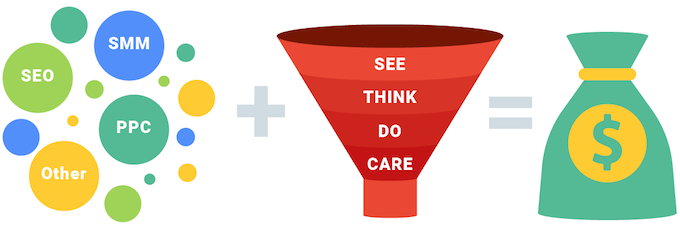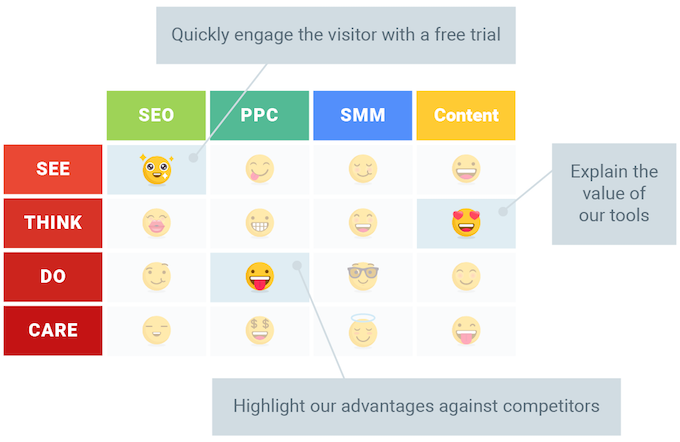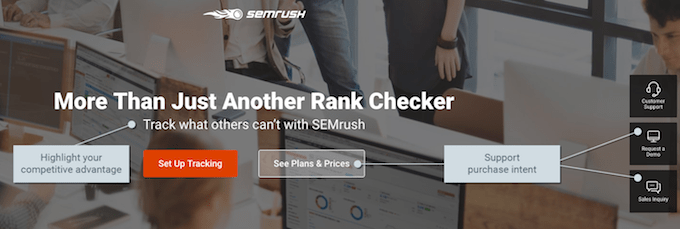May 25, 2018
Buyer personas represent your prospects and customers as a concept. The ability to meet their needs and answer their questions to the fullest is a clear competitive advantage. Therefore, a persona-based approach is used by many marketers to enhance customer experience, improve targeting accuracy, and harness behavioral analytics to their business objectives.
Buyer personas also play an important role in customer journey mapping. It’s obvious that people make purchase decisions in a variety of ways, and that considering the pros and cons of a certain product includes different stages and processes. The customer journey is literally the way your existing or potential customers interact with the company.
We at SEMrush decided to combine buyer persona profiles with customer journey maps to see if it can help us raise the effectiveness of our remarketing campaigns, stimulate the growth of conversions, increase retention, and reduce customer acquisition cost and cost per lead.
The challenge
SEMrush is perceived by many as a tool intended for SEOs, but in fact the company’s target audience is considerably larger. SEMrush offers toolkits for PPC, Content and Social Media specialists too. It makes sense, therefore, to tailor our marketing message for each of these groups.
Previously our remarketing approach was quite straightforward: if the user had visited a certain tool before, we were showing him ads of the same tool explaining its features and advantages. Despite all the positive results we were getting, this wasn’t encouraging the customers to use more tools and features (which is crucial for conversion and retention).
So we realized we needed to personalize our conversation with the customers and give a new twist to our remarketing strategy.
The solution: persona-based + stage-based matrix
The first step was grouping all our users by persona. SEO, PPC, Content, and Social Media fields of activity, respectively, formed the baseline for our buyer personas’ profiles. To find out which persona each user belonged to, we thoroughly analyzed their behavior: the tools they visited, the reports they downloaded, their overall SEMrush activity.
In addition to that, we embedded some surveys into our landing pages to double-check our findings.
The next step was incorporating these personas into the ‘see-think-do-care’ framework.

Customer journey stages were based on the way our users engaged with the company website:
See stage – users that are absolutely new to the website. They are not yet showing any commercial intent but might respond to an engaging message.
Goal: brand awareness
Target metrics: incoming traffic, conversion to registrations, cost-per-lead, visit depth, bounce rate, and traffic acquisition cost
Think stage – users that visited the website but left without registering. These users are ready to buy but at the moment they are looking around and choosing between several competing products.
Goal: showing our bright side
Target metrics: conversion to registrations, cost-per-lead
Do stage – registered users. At this stage the prospects are within an inch of purchasing. To make the last step they need a unique product and favourable purchase conditions.
Goal: purchase
Target metrics: conversion to first payments, CAC, conversion to paid users
Care stage – paid users. Loyal customers are the most valuable asset of any company and their motivation should be properly maintained.
Goal: retention and upsale
Target metrics: retention rate, number of account upgrades
Overlapping customer journey stages and buyer personas’ profiles gave us the following matrix:

So in the course of the experiment we were dealing with 16 different messages and delivering them was quite a task. Here’s an example of how we advertised our Position Tracking tool to SEO personas at the See and Do stages:

SEO (Position Tracking Tool) – See Stage

SEO (Position Tracking Tool) – Do stage
The results
Some of the results (significant for the extremely competitive B2B SaaS market):
- Average number of tools used by a customer – 23% growth
- Average conversion to registrations – 11% growth
- Conversion to payments – 9% growth
- In addition, we observed an increase in the number of registrations and conversions to payments per month.
All in all, although combining buyer personas’ profiles and customer journey maps requires some time for analysis and a thorough approach (you will have to make an exact profile of your target audience and utilize all available technology to facilitate their purchase decisions), the game is worth the candle!